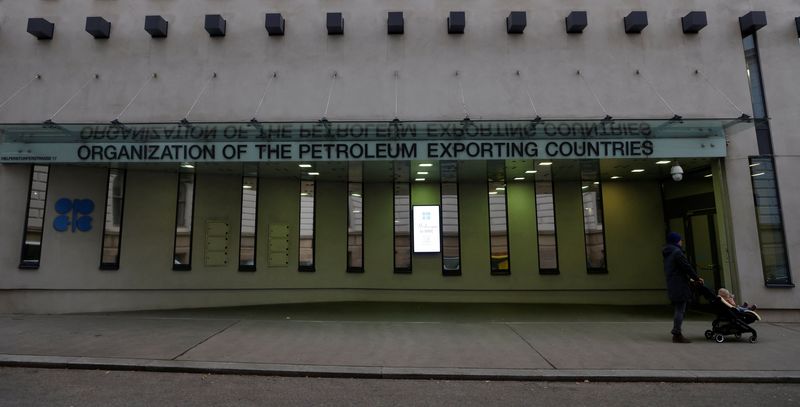By Maha El Dahan and Alex Lawler
DUBAI (Reuters) -OPEC+ members led by Saudi Arabia and Russia agreed on Sunday to extend voluntary oil output cuts of 2.2 million barrels per day into the second quarter, giving extra support to the market amid concerns over global growth and rising output outside the group.
Saudi Arabia, the de facto leader of the Organization of the Petroleum Exporting Countries (OPEC), said it would extend its voluntary cut of 1 million barrels per day (bpd) through the end of June, leaving its output at around 9 million bpd.
Russia, which leads OPEC allies collectively known as OPEC+, will cut oil production and exports by an extra 471,000 bpd in the second quarter. Russian Deputy Prime Minister Alexander Novak gave new figures showing that cuts from production will make up a rising proportion of the measure.
Oil has found support in 2024 from rising geopolitical tensions and Houthi attacks on Red Sea shipping, although concern about economic growth has weighed. While OPEC+ was widely expected to keep the cuts in place, Russia's announcement could bolster prices further.
"There was a surprise from Russia," said UBS analyst Giovanni Staunovo, who called the developments largely expected.
"If the Russian cuts are fully implemented additional barrels would be removed from the market. So that is a surprise move no one expected and could lift prices," he added.
Brent crude settled $1.64 higher, or 2%, at $83.55 a barrel on Friday, up more than 8% so far this year.
OPEC+ members announced the cuts individually on Sunday and OPEC later issued a statement confirming the 2.2 million bpd total. Saudi state news agency SPA said the cuts would be reversed gradually, according to market conditions.
"The decision sends a message of cohesion and confirms that the group in not in a hurry to return supply volumes, supporting the view that when this finally happens, it will be gradual," analysts at investment bank Jefferies said in a report.
OIL SEEN OPENING HIGHER
OPEC+ in November had agreed to the voluntary cuts totalling about 2.2 million bpd for the first quarter, led by Saudi Arabia rolling over a cut it had first made in July.
"The rollover was anticipated but extending it to the end of the second quarter might come as a surprise," said Tamas Varga of oil broker PVM. "The market is expected to open stronger."
For the second quarter, Iraq will extend its 220,000 bpd output cut, UAE will keep in place its 163,000 bpd output cut and Kuwait will maintain its 135,000 bpd output cut, the three OPEC producers said in separate statements. Algeria also said it would cut by 51,000 bpd and Oman by 42,000 bpd.
Kazakhstan said it will extend its voluntary cuts of 82,000 bpd through the second quarter.
OPEC+ has implemented a series of output cuts since late 2022 to support the market amid rising output from the United States and other non-member producers and worries over demand as major economies grapple with high interest rates.
The total OPEC+ pledged cuts since 2022 stand at about 5.86 million bpd, equal to about 5.7% of daily world demand, according to Reuters calculations.
Sources told Reuters last week that OPEC+ would consider extending the latest round of output cuts into the second quarter, with one saying it was "likely".

The oil demand outlook is uncertain for this year. OPEC expects another year of relatively strong demand growth of 2.25 million bpd, led by Asia, while the International Energy Agency expects much slower growth of 1.22 million bpd.
In a further headwind for OPEC+, the IEA also expects oil supply to grow to a record high of about 103.8 million bpd this year, almost entirely driven by producers outside OPEC+, including the United States, Brazil and Guyana.